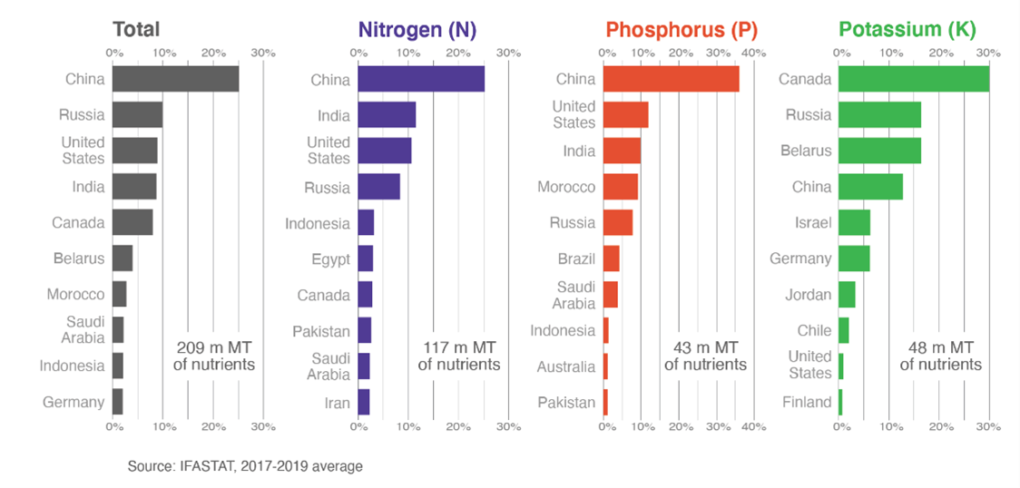Let’s Talk Farming Series
Saskatchewan farmers rely on a vast toolkit of technologies to produce their crops every year. Farming practices are always changing, and innovation and adoption of new technologies are vital to improving agricultural efficiency, productivity, and sustainability. This is the first in a series of blogs, #LetsTalkFarming, that will dive into some of the important technologies used by Saskatchewan farmers and discuss the current issues surrounding them.

What's the Scoop on Fertilizer?
Canadian farmers have a host of innovative technologies at their fingertips to help them grow the best crop possible. One of these technologies is fertilizer, which provides crops with the nutrients needed to emerge and grow. The four main macronutrients farmers apply to their crops are nitrogen (N), phosphorus (P), potassium (K), and sulphur (S). Based on soil health and conditions, farmers may apply other micronutrients as well.
Determining how to apply fertilizer and at what rate is an important part of a farmers’ cropping plan for the growing season. Nitrogen is the most common and most important nutrient added to crops when it comes to fertilizers. It helps plants photosynthesize and build necessary proteins, which are essential for making foods nutritious for humans.
Impacts of Rising Fertilizer Prices
In the last year, fertilizer prices have more than doubled for Canadian farmers. According to Fertilizer Canada, in 2021, the average farmer would have spent $60-$65 per acre on fertilizer and by 2022, this had increased to $130-$140 per acre. For the average farm of 778 acres, this would increase input costs by about $56,000. Other inputs, including fuel and chemical, have also risen in price. Even though farmers have enjoyed high market prices for their commodities over the last couple of years, these market gains are reduced by the ongoing increases in input costs. There are also concerns over falling grain prices which make the spike in input prices even more worrisome for farmers.
There are a number of reasons behind this spike in fertilizer prices. The main reason for the increase in price boils down to simple economics: global supply is not meeting global demand. China, the largest fertilizer supplier, put forward restrictions of fertilizer exports in 2021 which have negatively impacted supply. In addition, as Russia is the world’s fourth largest producer of nitrogen fertilizer, their invasion of Ukraine and the ensuing sanctions implemented by Western countries also negatively impacted fertilizer supply levels. Last fall Hurricane Ida shut down a number of fertilizer production plants in the southern United States which has also played a role in the supply issues.
Federal Plans to Reduce Fertilizer Emissions
Recently, our Federal Government announced impending mandates to reduce emissions associated with fertilizer use. These mandates, coupled with supply chain issues and rising fertilizer costs, are creating challenges for farmers when developing their cropping plans. Nitrogen fertilizers produce nitrous oxide (N2O), commonly known as laughing gas, which is the most potent of the three main greenhouse gases. Agricultural emissions of N2O largely come from nitrogen in the soil not taken up by plants, and therefore over-application of nitrogen fertilizer results in higher emissions. In Canadian agriculture, N2O represents about 21% of total emissions. In December 2020, the federal government announced a new goal of reducing fertilizer emissions by 30% below 2020 levels by the year 2030. This target is part of the federal government’s environmental goal of achieving net-zero emissions by 2050.
The government asserts that the objective of the target is not to introduce a mandatory reduction in fertilizer use that is not linked to improving efficiencies and maintaining yields. Instead, the stated objective is to maximize efficiencies, optimize fertilizer use, and encourage innovation and collaboration within the agricultural sector. However, it is difficult to see how, with the available technologies and only a ten-year timeline, the goal of emission reduction could be met without mandating use levels or introducing payments for farmers to change their practices. This target puts Canadian farmers in a difficult situation, by asking them to compromise on their input use, potentially impacting production levels and financial returns, without compensation, resources to recover those losses elsewhere, or support and direction as to how they can reduce their emissions by this amount without impacting production.
Farmers are Improving Fertilizer Use Efficiency
Regardless of potential federal mandates on fertilizer use, farmers have already begun improving the efficiency of their fertilizer use. With the value of fertilizer hitting record highs, it does not make sense for farmers to let any fertilizer go to waste. One way farmers are improving the efficiency of their fertilizer use is by conducting more frequent soil samples. Up-to-date soil samples help farmers know how much more fertilizer they need to apply to achieve their target yields without overapplying, saving both dollars and soil emissions. Some farmers are also making use of variable rate technology, allowing them to adjust their rates of application across a field based on detailed soil sample analysis and mapping. This technology makes it possible for parts of the field that are lacking in nutrients to receive higher fertilization than areas with higher base nutrient levels.
Another way farmers are minimizing their fertilizer use is by adjusting their crop rotations. For instance, pulse crops are able to fix their own nitrogen from the soil, requiring little to no additional nitrogen. A farmer who regularly grows canola and spring wheat might consider adding a pulse crop into their rotation to reduce their fertilizer bill for the upcoming year. Not only does this decision lower fertilizer input costs, but expanding crop rotations by adding pulse crops improves soil health as well. The incorporation of cover crops can also assist in reducing emissions by using up excess nitrogen in the soil. Slow-release fertilizer products can also assist in reducing emissions by releasing the nitrogen to plants slowly, minimizing potential losses by maximizing plant uptake.
Canadian farmers have the opportunity to participate in Fertilizer Canada’s 4R framework, which stands for using the Right Source at the Right Rate at the Right Time in the Right Place®. Implementing the 4Rs helps farmers improve efficiency and reduce losses. Furthermore, by improving fertilizer use efficiency, farmers are improving their profits per unit of fertilizer applied. Many farmers already practice 4R nutrient management on their farm without recognition. Formal 4R designation allows farmers to be recognized for their fertilizer stewardship efforts. As of 2019, 10.9 million out of a total 20.9 million canola acres in Western Canada were following 4R practices. Currently, 46% of the total Canadian 4R designated acres are located in Saskatchewan. On a national scale, having farmers and agribusinesses 4R designated shows how the Canadian agricultural industry is committed to sustainable farming practices that help to mitigate negative environmental impacts while still producing enough food to feed our global population.
Can Government Mandates Really Improve Fertilizer Use Efficiency?
Canadian farmers have already taken huge strides to improve the sustainability of their operations. When it comes to fertilizer use, farmers are increasingly improving their use efficiency and mitigating waste, especially with the spike in fertilizer prices. The federal government’s goal of reducing fertilizer emissions by 30% is likely unrealistic if farmers are to continue achieving their target yields and meeting food supply needs with current technologies. Furthermore, if Canadian production drops due to the required fertilizer reduction, countries may turn to less sustainable and efficient food producers to meet their demand, potentially leading to a less desirable global emission state. Overall, the federal mandate needs to be re-examined if we want to produce high-quality crops to feed and fuel our growing world population.



